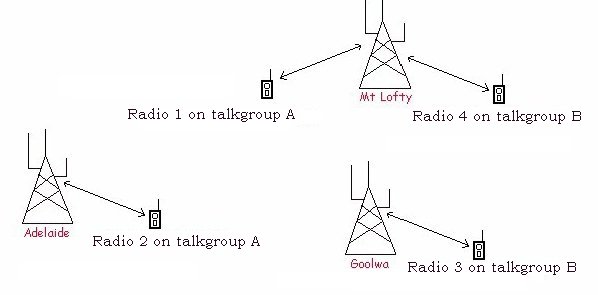|
Listening to the SA GRN
How it all works
The SA GRN offers users a combination of voice, data, and paging services to an area covering over 95% of South Australia's population. To maintain coverage over such a wide area a lot of frequencies and transmitter sites are required.
The trunking network uses a number of different voice and data frequencies at each site. As a user activates their press to talk button to transmit on a talkgroup the network controller (computer) allocates them an available voice channel from the site they are affiliated with, a voice channel is also allocated at any other sites where users on that talkgroup are located.
All sites have one frequency that constantly sends and receives information to and from radios - this is called the control channel. When switched on the radios transmit their ID number to the site on the control channel and tell it which talkgroup it is tuned to, this is called affiliation, the control channel also tells the radios which voice frequency to transmit and receive on.
Diagram 1 shows radio 1 affiliated with the Mt Lofty site, he wants to talk to radio 2 who is affiliated with the Adelaide site, they are both on talkgroup A. Radio 1 pushes his PTT button and is instantly allocated a voice channel from the Mt Lofty site, at the same time radio 2 is allocated a voice frequency from the Adelaide site so he can hear the transmission from radio 1. Anyone else with a radio on talkgroup A will also have a voice channel allocated from whatever site they are affiliated with and will therefore be able to hear radio 1.

Diagram 1
When radio 1 is finished transmitting the voice channel becomes inactive and another channel is allocated when radio 2 activates his PTT button to reply. The same thing is happening with radio 3 and 4 but because they are on a different talkgroup to radio 1 and 2 they cannot hear or talk to them.
If a site had five frequencies allocated to it one would be used as the control channel and the other four would be voice channels. If the number of users wanting to transmit is greater than the number of voice channels available then they will get a 'busy' tone on their radio and will have to wait for someone to stop transmitting before a frequency is available for them to use. This is why the busier sites on the GRN have the most frequencies allocated, whilst many of the rural sites with lower activity levels can have a minimum of four voice channels.
Each site has a backup control channel so that if interference or a problem is found with the primary control channel the site will immediately change to the backup one.
Back to Government Radio Network Page
|